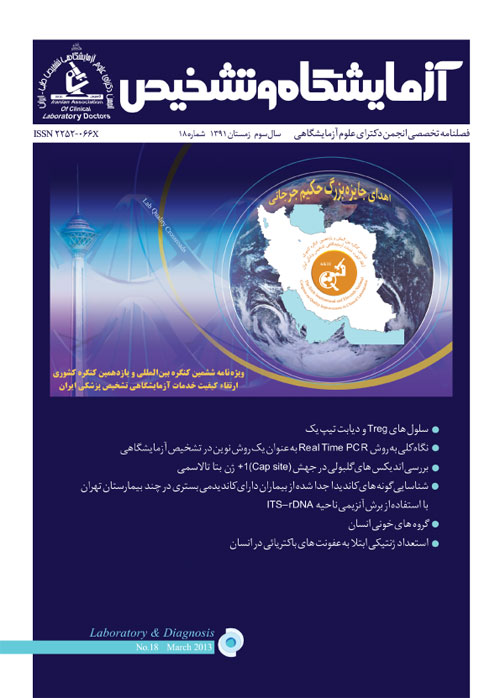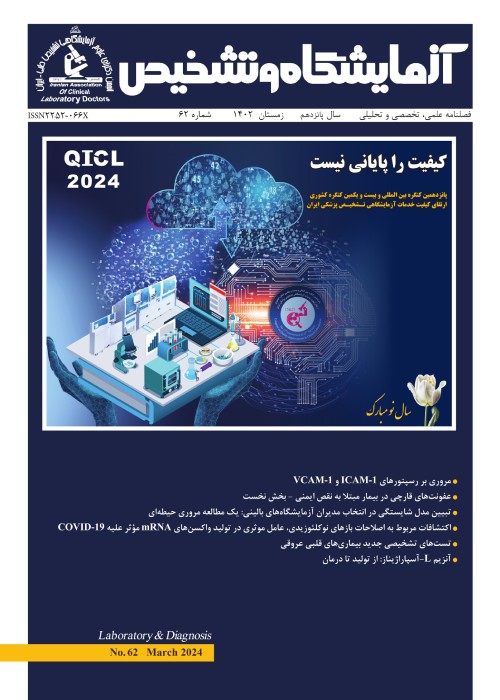فهرست مطالب

فصلنامه آزمایشگاه و تشخیص
پیاپی 18 (زمستان 1391)
- بهای روی جلد: 20,000ريال
- تاریخ انتشار: 1391/12/20
- تعداد عناوین: 14
-
صفحه 2
-
صفحه 5
-
صفحه 31
-
Page 15Beta thalassemia is a complex monogenic disease, and patient’s phenotypes are varied with location and type of mutations. Because of the complexity in detecting mutations in Beta thalassemia genes, despite medical efforts, in some cases, can lead to birth a new thalassemic patient. One thalassemic silent mutation is +1Cap that occurs in the 5>UTR of beta-globin genes. This mutation does not effected on RBC indexes and do not clear hematological changes. Therefore, the identification of clinical and phenotypic changes is almost impossible. However, this globins’ chain mutation accumulated with other mutations can be disastrous and lead to major beta thalassemia. Therefore these mutations whit worldwide distributions are important and detection of hematologic index with advances methods is necessary.
-
Page 19Candidemia is a very important infection in terms of incidence and mortality that caused by several species of the genus Candida and should be treated quickly. Even though Candida albicans is still the most common causative of Candidemia however, incidence of the blood infections due to non C. albicans species has increased in recent years. Species identification is necessary from the viewpoints of continuous epidemiological survey and susceptibility or resistance of different species to the antifungal drugs. In the current study a total of 48 different clinical isolates of Candida, obtained from blood specimens cultures belonging to 32 immunocompromised patients with candidemia who were hospitalized in some therapeutic centers in Tehran, were identified at the species level by a set of PCR-RFLP assays. The results indicated that species of C. parapsilosis, C. glabrata and C. albicans were respectively the most frequent agents. These findings were unexpected and should be considered because, C. albicans is almost always the most common cause of both candidemia and all clinical forms of candidiasis while, among the isolates of the current study it only ranked third in terms of abundance. Given to the relatively low number of studied isolates, it seems that a larger study is needed to confirm these results.Keywords: Candidemia, candidiasis, identification, PCR, RFLP, Tehran
-
Page 31Human, not only in genetic and morphological characters, but also in the type of blood that flows in their veins have differences. Every human being has one of the four main blood types that are allowed to take blood from any ABO blood group as its own. Now, the question is, which, when, where the first blood group evolved? The evolution of human blood groups, without doubt, is so old as man himself. There are at least there hypotheses about the emergence and mutation of human blood groups. Global distribution of blood groups depends on various environmental factors, such as disease, climate, altitude, humidity and etc. In this survey, the defection of main blood groups, ABO and Rh, along with some minor groups, such as Lutherans, Lewis, Duffy, Kidd and some other, are presented. Several investigation of blood groups from Iran, particularly a large sampling on 291857 individuals, including the main blood groups ABO and Rh, as well as minor blood groups such as Kell, Duffy, Lutheran, Kidd, Kp and Xg, have been reviewed.Keywords: Major blood groups, ABO, Rh, Minor blood groups, Iran
-
Page 37Infectious diseases, old and new, continue to be an important cause of mortality worldwide. A greater understanding of disease processes is needed if more effective therapies and more useful vaccines are to be produced. As part of this effort, developments in genetics have allowed a more systematic study of the impact that the human genome and infectious disease have on each other. In this review, we focus on common susceptibility variants, and also discuss somesingle-gene disorders that are associated with altered susceptibility to infectious disease.Keywords: Bacterial diseases, Genetics, Genetic susceptibility


